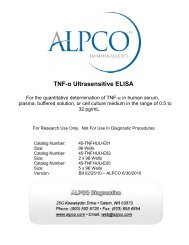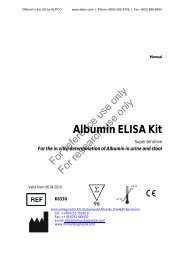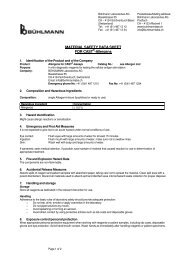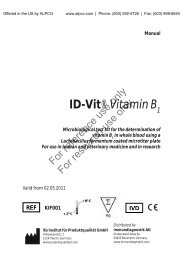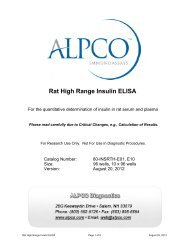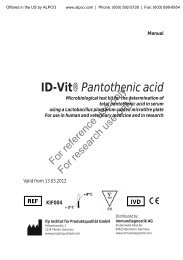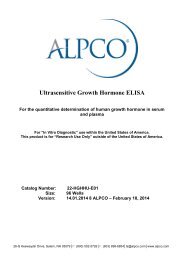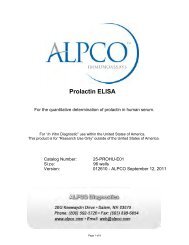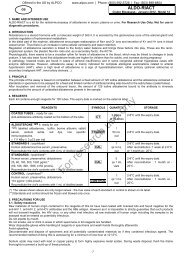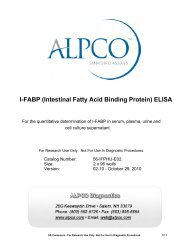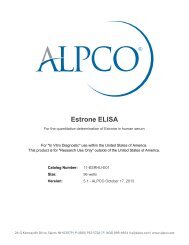EuroFlow - ALPCO Diagnostics
EuroFlow - ALPCO Diagnostics
EuroFlow - ALPCO Diagnostics
You also want an ePaper? Increase the reach of your titles
YUMPU automatically turns print PDFs into web optimized ePapers that Google loves.
Editorial<br />
1906<br />
The SME Cytognos SL particularly worked in the innovations of the<br />
Infinicyt software tools, which are now commercially available. The<br />
SME Dynomics (Rotterdam, The Netherlands) focused on the<br />
development of new antibodies particularly for the immunobead<br />
assay for detection of fusion proteins. The immunobead<br />
technology has been transferred by Dynomics to BD Biosciences<br />
(San Jose, CA, USA) for commercialization. The BCR-ABL immunobead<br />
assay 24 was launched in Autumn 2008 and the other<br />
immunobead assays will follow soon, such as the PML-RARA<br />
immunobead assay. 26<br />
<strong>EuroFlow</strong> is a consortium of scientific institutes and does not<br />
have production facilities or a distribution network for products<br />
related to its activities. However, to achieve production and<br />
distribution of the novel products and make the public investment<br />
money return into public (research) activities, the <strong>EuroFlow</strong><br />
Consortium Agreement (signed by all parties) indicated that<br />
intellectual property derived from the deliverables of the <strong>EuroFlow</strong><br />
project should be patented, and licensed to commercial<br />
companies that might be interested in large-scale (qualitycontrolled)<br />
production and distribution of the <strong>EuroFlow</strong> deliverables<br />
for rapid availability to the field. In parallel, all institutions<br />
and individual <strong>EuroFlow</strong> members declined their rights on<br />
revenues (such as royalty rights) in favor of the <strong>EuroFlow</strong><br />
Consortium, to provide sustainability for future activities<br />
and projects of the group, including Educational Workshops and<br />
Educational Symposia (Table 4).<br />
WHICH EUROFLOW ACTIVITIES ARE STILL ONGOING?<br />
The current activities of the <strong>EuroFlow</strong> Consortium concern:<br />
(1) Building the reference databases and templates for the whole<br />
set of <strong>EuroFlow</strong> antibody panels to be linked to the software<br />
tools (Infinicyt software) that are already available.<br />
(2) Design of innovative strategies for the detection of minimal<br />
residual disease (MRD) during and after therapy in patients<br />
that have reached complete remission according to conventional<br />
criteria. The new strategies search for disease-oriented<br />
single-tube combinations instead of patient-specific multicolor<br />
antibody panels. This new MRD strategy takes advantage of all<br />
new data analysis software tools and reference databases<br />
collected previously.<br />
(3) Because of the successful innovation and standardization in<br />
the hemato–oncology field, the <strong>EuroFlow</strong> Consortium has now<br />
decided to extend its activities to flow cytometric diagnosis<br />
for other diseases such as primary immunodeficiencies. In this<br />
context, more detailed studies on normal lymphocyte subsets<br />
are being performed. These studies show that more than eight<br />
colors might be needed to fully unravel all relevant B- and<br />
T-cell subsets and their memory and effector pathways.<br />
CONCLUSION: EUROFLOW TOOLS FOR COMPANION<br />
DIAGNOSTICS IN PERSONALIZED MEDICINE<br />
In the current era of personalized medicine, many different new<br />
treatment options are being evaluated to further improve<br />
treatment outcome while increasing quality of life, such as<br />
treatment with antibodies and small (blocking) molecules. The<br />
implementation and evaluation of such new treatment modalities<br />
requires accurate diagnosis and classification of the disease and<br />
careful monitoring of treatment effectiveness. Consequently, the<br />
applied diagnostics should be optimally suited for the management<br />
of the involved patients. Such companion diagnostics is<br />
currently particularly needed for patients with a hematological<br />
malignancy, because the field of hemato–oncology is ahead of the<br />
other fields in medicine.<br />
The <strong>EuroFlow</strong> antibody panels and technical protocols have<br />
been developed for application as companion diagnostics for<br />
(inter)national clinical treatment protocols, where standardization<br />
and reproducibility are of utmost importance. In this way, the<br />
<strong>EuroFlow</strong> achievements can contribute to advanced comparability<br />
of innovative clinical treatment protocols and thereby to further<br />
improvement of diagnostic and therapeutic patient care.<br />
CONFLICT OF INTEREST<br />
JJMvD and AO are the coordinators of the <strong>EuroFlow</strong> Consortium and are inventors of<br />
the <strong>EuroFlow</strong> patent ‘Methods, reagents and kits for flow cytometric immunophenotyping’<br />
(PCT/NL2010/050332), together with 13 other <strong>EuroFlow</strong> members. The patent describes<br />
the composition of the <strong>EuroFlow</strong> antibody combinations for diagnosis and classification<br />
of hematological malignancies. The patent has been licensed to the companies BD<br />
Biosciences and Cytognos for making the antibody combinations commercially available<br />
as full-tube combinations in order to speed up the immunostaining process. The patent<br />
is collectively owned by the <strong>EuroFlow</strong> Consortium and the revenues of the patent are<br />
exclusively used for <strong>EuroFlow</strong> Consortium activities, such as for covering (in part) the<br />
costs of the Consortium meetings, the <strong>EuroFlow</strong> Educational Workshops and the<br />
purchase of custom-made reagents for collective experiments.<br />
ACKNOWLEDGEMENTS<br />
We are grateful to Dr Jean-Luc Sanne of the European Commission for his support<br />
and monitoring of the <strong>EuroFlow</strong> project. We thank the <strong>EuroFlow</strong> Consortium<br />
members for their professional contribution to the success of the <strong>EuroFlow</strong><br />
Consortium and for their support and friendship. We thank Juan Flores-Montero<br />
for his support to complete this Editorial and Marieke Comans-Bitter for her<br />
continuous support in the management of the <strong>EuroFlow</strong> Consortium. We thank Bibi<br />
van Bodegom, Caroline Linker and Monique van Rossum for their secretarial and<br />
organizational support of the consortium activities. We are grateful to Ria Bloemberg<br />
and Gellof van Steenis for support in the financial management of the project funds.<br />
JJM van Dongen 1 and A Orfao 2 on behalf of the<br />
<strong>EuroFlow</strong> Consortium<br />
1 Department of Immunology, Erasmus MC, University Medical<br />
Center, Rotterdam, Dr Molewaterplein 50, 3015 GE,<br />
The Netherlands and<br />
2 Department of Medicine, Cancer Research Center<br />
(IBMCC-CSIC-USAL) and Cytometry Service,<br />
University of Salamanca, Salamanca, Spain<br />
E-mail: f.linker@erasmusmc.nl<br />
REFERENCES<br />
1 Swerdlow SH, Campo E, Harris NL, Jaffe ES, Pileri SA, Stein H et al.<br />
WHO Classification of Tumours of Haematopoietic and Lymphoid Tissues. 4th edn.<br />
International Agency for Research on Cancer: Lyon, 2008, 439 pp.<br />
2 Szczepanski T, Orfao A, van der Velden VH, San Miguel JF, van Dongen JJ. Minimal<br />
residual disease in leukaemia patients. Lancet Oncol 2001; 2: 409–417.<br />
3 Orfao A, Schmitz G, Brando B, Ruiz-Arguelles A, Basso G, Braylan R et al. Clinically<br />
useful information provided by the flow cytometric immunophenotyping of<br />
hematological malignancies: current status and future directions. Clin Chem 1999;<br />
45: 1708–1717.<br />
4 Szczepanski T, van der Velden VH, van Dongen JJ. Flow-cytometric immunophenotyping<br />
of normal and malignant lymphocytes. Clin Chem Lab Med 2006; 44:<br />
775–796.<br />
5 Davis BH, Holden JT, Bene MC, Borowitz MJ, Braylan RC, Cornfield D et al. 2006<br />
Bethesda International Consensus recommendations on the flow cytometric<br />
immunophenotypic analysis of hematolymphoid neoplasia: medical indications.<br />
Cytometry B Clin Cytom 2007; 72(Suppl 1): S5–S13.<br />
6 Craig FE, Foon KA. Flow cytometric immunophenotyping for hematologic<br />
neoplasms. Blood 2008; 111: 3941–3967.<br />
7 Kraan J, Gratama JW, Haioun C, Orfao A, Plonquet A, Porwit A et al. Flow<br />
cytometric immunophenotyping of cerebrospinal fluid. Curr Protoc Cytom 2008;<br />
Chapter 6 Unit 6.25.<br />
8 Paiva B, Almeida J, Perez-Andres M, Mateo G, Lopez A, Rasillo A et al. Utility of flow<br />
cytometry immunophenotyping in multiple myeloma and other clonal plasma<br />
cell-related disorders. Cytometry B Clin Cytom 2010; 78: 239–252.<br />
9 Bene MC, Nebe T, Bettelheim P, Buldini B, Bumbea H, Kern W et al. Immunophenotyping<br />
of acute leukemia and lymphoproliferative disorders: a consensus<br />
Leukemia (2012) 1899 – 1907<br />
& 2012 Macmillan Publishers Limited



